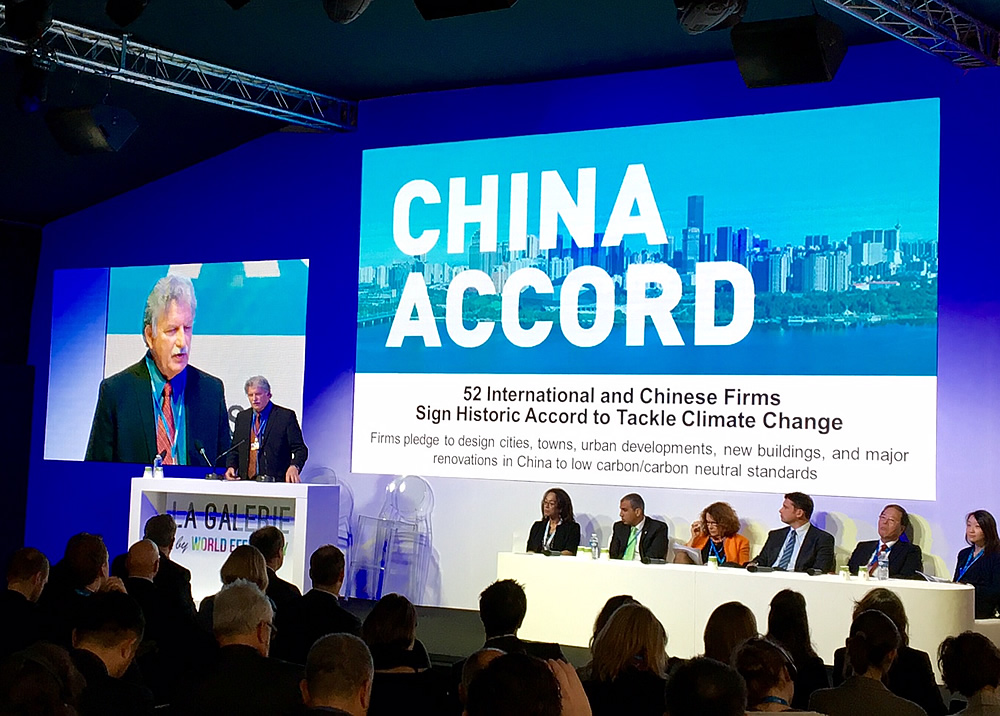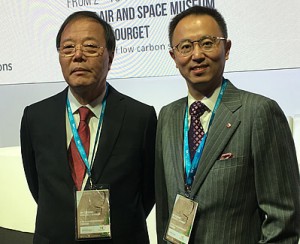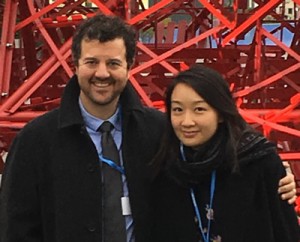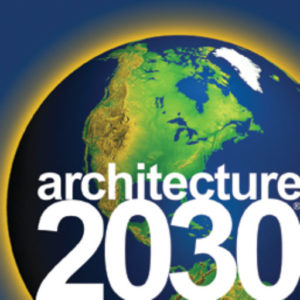Paris to World: an End to the Fossil Fuel Era
December 2015 | Research & Analysis | International

Last week, the world came together in Paris for the 21st Conference of the Parties (COP21) of the U.N. Framework Convention on Climate Change (UNFCC), and signed a historic agreement. At the heart of the Paris Agreement is the “long-term goal” committing almost 200 countries – including the U.S., China, India, and the EU nations – to keep the global average temperature increase to “well below 2°C above pre-industrial levels and to pursue efforts to limit the temperature increase to 1.5°C.”
To meet this target, the world must reach zero fossil fuel CO2 emissions in the urban built environment by about 2050, and zero total global greenhouse gas emissions by 2060 to 2080.
What’s in the Agreement
The agreement commits all countries to “aim to reach global peaking of greenhouse gas emissions as soon as possible . . . and to undertake rapid reductions thereafter”. It includes 188 national government submissions – Intended Nationally Determined Contributions (INDCs) – containing the actions each country intends to take to reduce greenhouse gas (GHG) emissions.
These initial INDCs admittedly do not go far enough to meet the 1.5°C target, but each country is required to renew its pledge with increasingly stringent targets every five years. The current U.S. INDC pledge is to reduce greenhouse gas emissions 26% to 28% below 2005 levels by 2025.
But most importantly, the impact of the agreement is clear – governments have signaled an end to the fossil fuel era by committing for the first time to cut GHG emissions and avoid the most egregious impacts of climate change.
The Agreement and the Built Environment
Another historic event at COP21 was the first ever UNFCCC Buildings Day – an entire day devoted to the building sector in recognition of the important role it must play in ensuring that countries meet their emissions reduction obligations.

Ed Mazria presenting the China Accord at the UNFCCC COP21 Buildings Day
Architecture 2030 helped organize Buildings Day, and Ed Mazria, Architecture 2030 Founder and CEO, delivered the opening presentation titled “Road to Zero”, which successfully set the tone for the remainder of the day. Referencing Architecture 2030’s submission to the UNFCCC – the Roadmap to Zero Emissions: The Built Environment in a Global Transformation to Zero Emissions report – he demonstrated how a combination of reducing the built environment’s demand for fossil fuel energy while increasing the world’s supply of renewable energy sources will meet the Paris Agreement’s long-term 1.5°C goal.
In addition, Mazria presented the China Accord for the first time to the UNFCCC and the international audience in attendance, illustrating how the architecture, planning, and building design community in China will play a key role in making the agreement’s targets a reality.

Chen Zhen, Secretary General of CEDAAB (left) and Leon Qiu, Vice Secretary General of CEDAAB and Principal at DLR Group
The Accord is a commitment by 52 key Chinese and international architecture and planning firms to plan and design cities, towns, developments, and buildings in China to low carbon/carbon neutral standards.
Chen Zhen, Secretary General of the China Exploration & Design Association – Architecture Branch (CEDAAB), also delivered a speech at the opening of Buildings Day on the importance of international collaboration and China’s commitment to low carbon development. According to Zhen,
“The China Accord is a manifestation of the determination and moral obligations of planners and architects both in China and internationally, that we are taking huge strides to reduce carbon emissions and move towards zero carbon.”
At COP21, bold actions such as the China Accord underlined the importance of cities and the built environment in combatting climate change, giving nations the confidence to take dramatic steps in Paris.
Cities consume nearly 75% of global energy production and are responsible for a similar percentage of global GHG emission. Tokyo, for example, is responsible for the same amount of GHG emissions as the 37 least polluting African countries.

Architecture 2030’s representatives at COP21: Panama Bartholomy, EU Lead, and Yaki Wo,
Asia Lead
COP21 is also the first time that cities have had their voices fully recognized at a global UN conference on climate change, and the first time over 1,000 city and regional officials gathered to demand bold action.
436 cities have signed the Compact of Mayors pledging to reduce greenhouse gas emissions and track their progress.
These include 117 U.S. cities, with total average U.S. city pledges at 68% GHG emissions reductions below their current levels by 2050.
In addition to the China Accord and the local government pledges, many other initiatives were announced during COP21, including:
- 123 jurisdictions (states, provinces, regions, and cities) collectively representing more than 720 million people and $19.9 trillion in combined GDP, equivalent to more than a quarter of the global economy, joined the Under 2 MOU agreement, pledging to limit emissions to 80% to 95% below 1990 levels, or below 2 metric tons per capita, by 2050.
- Over 100 banks, managing a total of $4 trillion in assets, called for a doubling of building energy efficiency by 2030.
- Over 150 US companies committed to reduce energy use in their facilities by 50%.
- The Global Alliance for Buildings and Construction, a global private-public alliance was established to foster closer collaboration and new partnerships in the buildings sector.
- The World Green Building Council (WGBC) announced that GBCs in Canada, Australia, and South Africa are developing Carbon Neutral building certifications, signaling that this is where the market is headed. The WGBC and Architecture 2030 are planning to collaborate to help develop the certification and then to expand it into other global markets.
2016 and Beyond
The Paris Agreement introduces a new world, one that envisions an end to fossil fuel emissions and secures a strong mechanism to address climate change.
As Architecture 2030’s senior consultant Farhana Yamin (also CEO of Track 0 and advisor to the Marshall Islands) put it:
“There is a huge way to go, but there are already people out there working on envisioning what a Zero by 2050 world looks like.”
So open your champagne bottles, and toast the promise of not just another New Year, but also a new era of international collaboration in creating a sustainable, resilient, and highly livable planet.
ABOUT US
Architecture 2030’s mission is to rapidly transform the built environment from the major contributor of greenhouse gas emissions to a central solution to the climate crisis.



